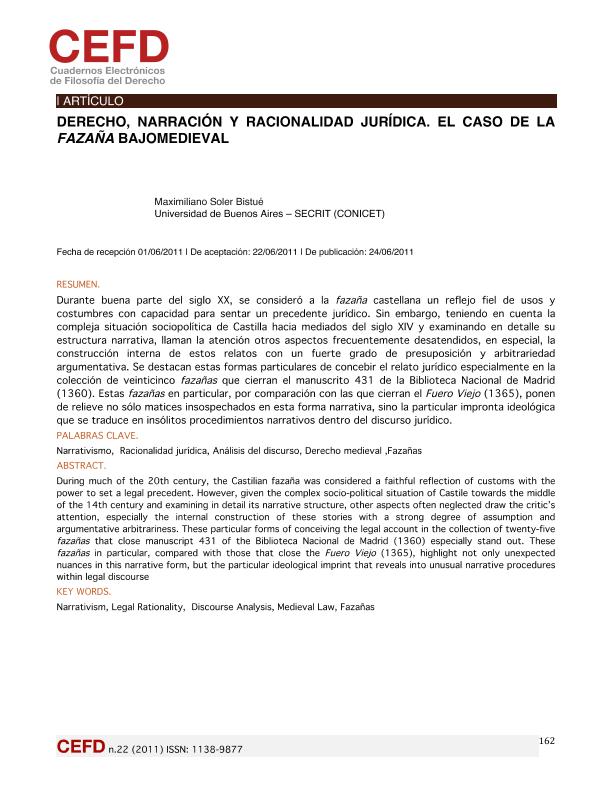Mostrar el registro sencillo del ítem
dc.contributor.author
Soler Bistué, Maximiliano Augusto

dc.date.available
2017-03-15T18:34:32Z
dc.date.issued
2011-06
dc.identifier.citation
Soler Bistué, Maximiliano Augusto; Derecho, narración y racionalidad jurídica. El caso de la fazaña medieval; Universitat de València.Estudi General. Sociedad Española de Filosofía Jurídica y Política; Cuadernos Electrónicos de Filosofía del Derecho; 22; 6-2011; 162-189
dc.identifier.issn
1138-9877
dc.identifier.uri
http://hdl.handle.net/11336/13911
dc.description.abstract
Durante buena parte del siglo XX, se consideró a la "fazaña" castellana un reflejo fiel de usos y costumbres con el poder de sentar un precedente jurídico. Sin embargo, teniendo en cuenta la compleja situación sociopolítica de Castilla hacia mediados del siglo XIV y examinando en detalle su estructura narrativa, llaman la atención otros aspectos frecuentemente desatendidos, en especial, la construcción interna de estos relatos con un fuerte grado de presuposición y arbitrariedad argumentativa. Se destacan estas formas particulares de concebir el relato jurídico especialmente en la colección de veinticinco "fazañas" que cierran el manuscrito 431 de la Biblioteca Nacional de Madrid (1360). Estas "fazañas" en particular, en comparación con las que cierran el "Fuero Viejo"(1365), ponen de relieve no sólo matices insospechados en esta forma narrativa, sino la particular impronta ideológica que se traduce en insólitos procedimientos narrativos dentro del discurso jurídico.
dc.description.abstract
During much of the 20th century, the Castilian fazaña was considered a faithful reflection of customs with the power to set a legal precedent. However, given the complex socio-political situation of Castile towards the middle of the 14th century and examining in detail its narrative structure, other aspects often neglected draw the critic’s attention, especially the internal construction of these stories with a strong degree of assumption and argumentative arbitrariness. These particular forms of conceiving the legal account in the collection of twenty-five fazañas that close manuscript 431 of the Biblioteca Nacional de Madrid (1360) especially stand out. These fazañas in particular, compared with those that close the Fuero Viejo (1365), highlight not only unexpected nuances in this narrative form, but the particular ideological imprint that reveals into unusual narrative procedures within legal discourse.
dc.format
application/pdf
dc.language.iso
spa
dc.publisher
Universitat de València.Estudi General. Sociedad Española de Filosofía Jurídica y Política
dc.rights
info:eu-repo/semantics/openAccess
dc.rights.uri
https://creativecommons.org/licenses/by-nc-nd/2.5/ar/
dc.subject
Narratología
dc.subject
Racionalidad Jurídica
dc.subject
Análisis del Discurso
dc.subject
Fazaña Medieval
dc.subject.classification
Otras Lengua y Literatura

dc.subject.classification
Lengua y Literatura

dc.subject.classification
HUMANIDADES

dc.title
Derecho, narración y racionalidad jurídica. El caso de la fazaña medieval
dc.type
info:eu-repo/semantics/article
dc.type
info:ar-repo/semantics/artículo
dc.type
info:eu-repo/semantics/publishedVersion
dc.date.updated
2017-03-14T15:06:50Z
dc.journal.number
22
dc.journal.pagination
162-189
dc.journal.pais
España

dc.journal.ciudad
Valencia
dc.description.fil
Fil: Soler Bistué, Maximiliano Augusto. Consejo Nacional de Investigaciones Científicas y Técnicas. Oficina de Coordinación Administrativa Saavedra 15. Instituto de Investigaciones Bibliográficas y Crítica Textual. Subsede "seminario Orduna"; Argentina. Universidad de Buenos Aires; Argentina
dc.journal.title
Cuadernos Electrónicos de Filosofía del Derecho
dc.relation.alternativeid
info:eu-repo/semantics/altIdentifier/url/http://ojs.uv.es/index.php/CEFD/article/view/908
Archivos asociados
